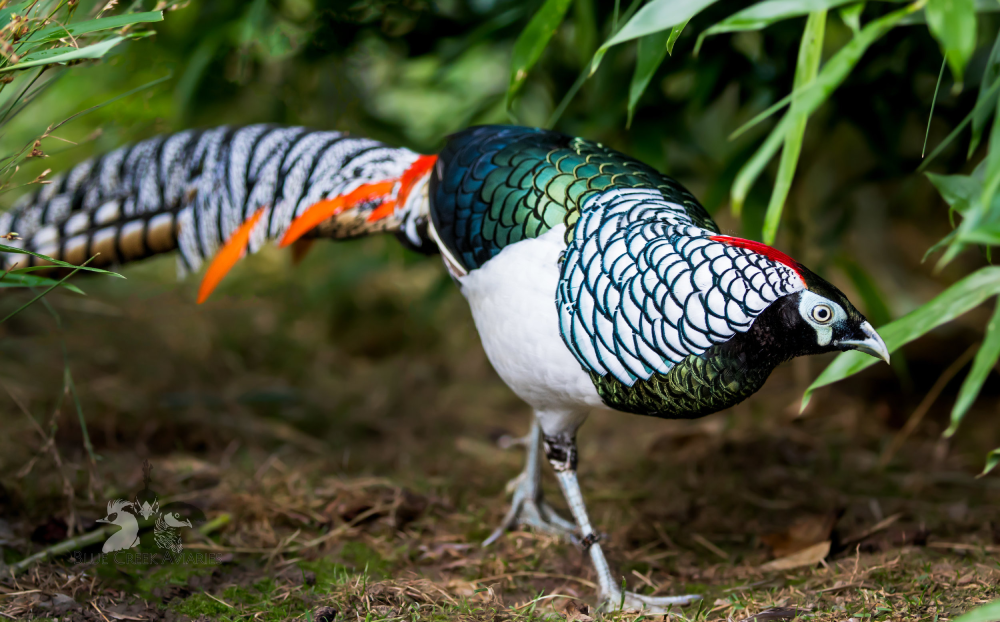Lady Amherst’s Pheasant (Chrysolophus amherstiae) is a bird of striking beauty, belonging to the Phasianidae family. Named after Sarah Amherst, the wife of William Pitt Amherst, Governor-General of India, who was instrumental in introducing the bird to the Western world in the early 19th century, this pheasant is native to southwestern China and northern Myanmar. Over the years, it has captivated bird enthusiasts and ornithologists alike, not just for its vibrant plumage but also for its intriguing behaviors and ecological significance.
Physical Description
Lady Amherst’s Pheasant is popular for its spectacular plumage, which is a vivid mosaic of colors and patterns. The male is particularly eye-catching with a metallic green crest and elongated, barred tail feathers that can measure up to 80 centimeters in length. The body showcases an array of colors, including blue, green, red, yellow, and white. The chest and upper back are adorned with black and white stripes, while the lower back features a bright yellow. In contrast, the female, though less flamboyant, is elegantly adorned with a more subdued, cryptic brown and black pattern, which provides camouflage in their natural habitat.
Habitat and Distribution
Originally found in the dense, subtropical forests of southwestern China and northern Myanmar, Lady Amherst’s Pheasant has adapted to various environments, including bamboo thickets and forest edges. These habitats provide ample cover and food resources, such as seeds, fruits, and small invertebrates. Although they have been introduced to other regions, including parts of Europe and North America, successful wild populations outside their native range are rare and often confined to managed estates or avian collections.

Behavior and Ecology
Lady Amherst’s Pheasant is primarily terrestrial, spending most of its time foraging on the forest floor. Despite their vibrant plumage, they are elusive birds, often remaining hidden in dense underbrush. Their diet is omnivorous, consisting mainly of seeds, leaves, berries, and insects. They are popular for their strong legs and feet. These are perfect for scratching the forest floor in search of food.
These pheasants are generally solitary or found in small groups. During the breeding season, males become particularly territorial and perform elaborate courtship displays to attract females. These displays include fanning their tail feathers, puffing up their plumage, and engaging in a series of intricate movements to showcase their vibrant colors. The mating call, a series of high-pitched whistles, is also a key component of their courtship ritual.
Reproduction
The breeding season for Lady Amherst’s Pheasant typically occurs in late spring and early summer. After a successful courtship, the female lays a clutch of 6-12 eggs in a shallow nest on the ground, concealed among dense vegetation. The incubation period lasts about 24-26 days, during which the female diligently tends to the eggs. Upon hatching, the chicks are precocial, meaning they are relatively mature and mobile from the moment they emerge, covered in downy feathers and capable of leaving the nest within a few hours.
Conservation Status
Although Lady Amherst’s Pheasant is not currently listed as endangered, it faces several threats in the wild. Habitat loss due to deforestation and agricultural expansion is a significant concern. Additionally, hunting and trapping for the pet trade have also contributed to local population declines. In some regions, hybridization with the closely related Golden Pheasant (Chrysolophus pictus) poses a threat to the genetic integrity of wild populations.
Conservation efforts have been implemented in various parts of their range to address these issues. Protected areas and wildlife reserves play a crucial role in preserving their natural habitat. Captive breeding programs and the establishment of managed populations in aviaries and private estates have also contributed to the species’ conservation, ensuring that Lady Amherst’s Pheasant remains a vibrant presence in aviculture and the wild.
Cultural Significance
Lady Amherst’s Pheasant has long been a symbol of beauty and elegance. In China, the bird is considered a good omen and is often depicted in art and literature. Its striking appearance has made it a popular subject in traditional Chinese paintings and embroidery. The pheasant’s name commemorates Sarah Amherst’s contributions to natural history, highlighting the interconnectedness of cultural and scientific endeavors in the study and appreciation of wildlife.
Conclusion
Lady Amherst’s Pheasant is a testament to the intricate beauty and diversity of the natural world. Its vibrant plumage, intriguing behaviors, and ecological significance make it a fascinating subject for ornithologists and bird enthusiasts alike. While the species faces challenges in the wild, ongoing conservation efforts and a deep appreciation for its splendor continue to ensure that Lady Amherst’s Pheasant remains a cherished jewel of the avian world.









